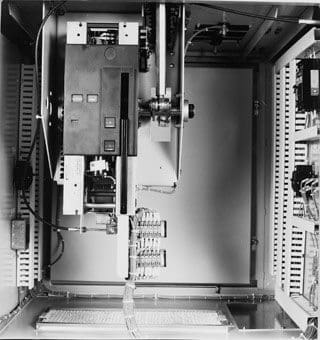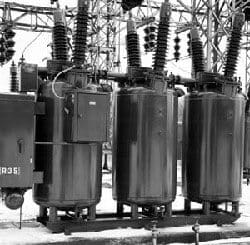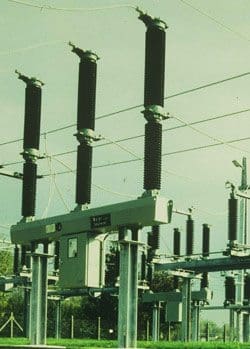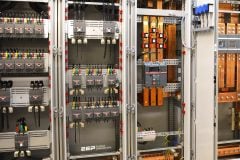
A circuit breaker is defined as “a mechanical switching device capable of making, carrying and breaking currents under normal circuit conditions and also making, carrying and breaking for a specified time, and breaking currents under specified abnormal circuit conditions such as a short circuit”(IEEE Std. C37.100).
Circuit breakers are generally classified according to the interrupting medium used to cool and elongate the electrical arc permitting interruption.
The circuit breaker types are:
• Air magnetic
• Oil
• Air blast
• Vacuum
• SF6 gas
Air magnetic circuit breakers are limited to older switchgear and have generally been replaced by vacuum or SF6 for switchgear applications. Vacuum is used for switchgear applications and some outdoor breakers, generally 38 kV class and below. Air blast breakers, used for high voltages (≥765 kV), are no longer manufactured and have been replaced by breakers using SF6 technology.
Oil circuit breakers have been widely used in the utility industry in the past but have been replaced by other breaker technologies for newer installations. Two designs exist: bulk oil (dead-tank designs) dominant in the U.S.; and oil minimum breaker technology (live-tank design). Bulk oil circuit breakers were designed as single-tank or three-tank mechanisms; generally, at higher voltages, three-tank designs were dominant.
Environmental concerns forcing the necessity of oil retention systems, maintenance costs, and the development of the SF6 gas circuit breaker have led to the gradual replacement of the oil circuit breaker for new installations.

Oil circuit breaker development has been relatively static for many years. The design of the interrupter employs the arc caused when the contacts are parted and the breaker starts to operate. The electrical arc generates hydrogen gas due to the decomposition of the insulating mineral oil. The interrupter is designed to use the gas as a cooling mechanism to cool the arc and to use the pressure to elongate the arc through a grid (arc chutes), allowing extinguishing of the arc when the current passes through zero.
Vacuum circuit breakers use an interrupter that is a small cylinder enclosing the moving contacts under a high vacuum. When the contacts part, an arc is formed from contact erosion. The arc products are immediately forced to and deposited on a metallic shield surrounding the contacts. Without anything to sustain the arc, it is quickly extinguished.
Vacuum circuit breakers are widely employed for metal-clad switchgear up to 38 kV class. The small size of the breaker allows vertically stacked installations of breakers in a two-high configuration within one vertical section of switchgear, permitting significant savings in space and material compared to earlier designs employing air magnetic technology. When used in outdoor circuit breaker designs, the vacuum cylinder is housed in a metal cabinet or oil-filled tank for dead tank construction popular in the U.S. market.

Gas circuit breakers generally employ SF6 (sulfur hexaflouride) as an interrupting and sometimes as an insulating medium. In “single puffer”mechanisms, the interrupter is designed to compress the gas during the opening stroke and use the compressed gas as a transfer mechanism to cool the arc and to elongate the arc through a grid (arc chutes), allowing extinguishing of the arc when the current passes through zero.
In other designs, the arc heats the SF6 gas and the resulting pressure is used for elongating and interrupting the arc. Some older two-pressure SF6 breakers employed a pump to provide the high-pressure SF6 gas for arc interruption.
Gas circuit breakers typically operate at pressures between six and seven atmospheres. The dielectric strength of SF6 gas reduces significantly at lower pressures, normally as a result of lower ambient temperatures. Monitoring of the density of the SF6 gas is critical and some designs will block operation of the circuit breaker in the event of low gas density.
Circuit breakers are available as live-tank or dead-tank designs. Dead-tank designs put the interrupter in a grounded metal enclosure. Interrupter maintenance is at ground level and seismic withstand is improved vs. the live-tank designs. Bushings are used for line and load connections which permit installation of bushing current transformers for relaying and metering at a nominal cost.
The dead-tank breaker does require additional insulating oil or gas to provide the insulation between the interrupter and the grounded tank enclosure.

Live-tank circuit breakers consist of an interrupter chamber that is mounted on insulators and is at line potential. This approach allows a modular design as interrupters can be connected in series to operate at higher voltage levels. Operation of the contacts is usually through an insulated operating rod or rotation of a porcelain insulator assembly by an operator at ground level. This design minimizes the quantity of oil or gas used for interrupting the arc as no additional quantity is required for insulation of a dead tank enclosure. The design also readily adapts to the addition of pre-insertion resistors or grading capacitors when they are required. Seismic capability requires special consideration due to the high center of gravity of the interrupting chamber assembly.
Interrupting times are usually quoted in cycles and are defined as the maximum possible delay between energizing the trip circuit at rated control voltage and the interruption of the main contacts in all poles. This applies to all currents from 25 to 100% of the rated short-circuit current.
Circuit breaker ratings must be examined closely. Voltage and interrupting ratings are stated at a maximum operating voltage rating, i.e., 38 kV voltage rating for a breaker applied on a nominal 34.5-kV circuit. The breakers have an operating range designated as K factor per IEEE C37.06.
For a 72-kV breaker, the voltage range is 1.21, indicating that the breaker is capable of its full interrupting rating down to a voltage of 60 kV. Breaker ratings need to be checked for some specific applications. Applications requiring reclosing operation should be reviewed to be sure that the duty cycle of the circuit breaker is not being exceeded.
Some applications for out-of-phase switching or back-to-back switching of capacitor banks also require review and may require specific-duty circuit breakers to insure proper operation of the circuit breaker during fault interruption.
Reference: High-Voltage Switching Equipment by David L. Harris











I would like to get more information about electrical engineering,am enjoying ur learning